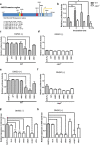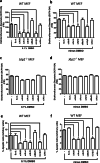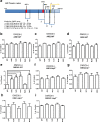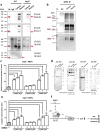Dimethyl sulfoxide stimulates the AhR-Jdp2 axis to control ROS accumulation in mouse embryonic fibroblasts
- PMID: 33723743
- PMCID: PMC8986748
- DOI: 10.1007/s10565-021-09592-2
Dimethyl sulfoxide stimulates the AhR-Jdp2 axis to control ROS accumulation in mouse embryonic fibroblasts
Abstract
The aryl hydrocarbon receptor (AhR) is a ligand-binding protein that responds to environmental aromatic hydrocarbons and stimulates the transcription of downstream phase I enzyme-related genes by binding the cis element of dioxin-responsive elements (DREs)/xenobiotic-responsive elements. Dimethyl sulfoxide (DMSO) is a well-known organic solvent that is often used to dissolve phase I reagents in toxicology and oxidative stress research experiments. In the current study, we discovered that 0.1% DMSO significantly induced the activation of the AhR promoter via DREs and produced reactive oxygen species, which induced apoptosis in mouse embryonic fibroblasts (MEFs). Moreover, Jun dimerization protein 2 (Jdp2) was found to be required for activation of the AhR promoter in response to DMSO. Coimmunoprecipitation and chromatin immunoprecipitation studies demonstrated that the phase I-dependent transcription factors, AhR and the AhR nuclear translocator, and phase II-dependent transcription factors such as nuclear factor (erythroid-derived 2)-like 2 (Nrf2) integrated into DRE sites together with Jdp2 to form an activation complex to increase AhR promoter activity in response to DMSO in MEFs. Our findings provide evidence for the functional role of Jdp2 in controlling the AhR gene via Nrf2 and provide insights into how Jdp2 contributes to the regulation of ROS production and the cell spreading and apoptosis produced by the ligand DMSO in MEFs.
Keywords: AhR; Dimethyl sulfoxide; Jun dimerization protein 2; Mouse embryonic fibroblasts; Nrf2; Reactive oxygen species.
© 2021. The Author(s).
Conflict of interest statement
The authors declare no competing interests.
Figures







Similar articles
-
New insights into coordinated regulation of AHR promoter transcription; molecular mechanisms and therapeutic targets.Int J Biol Sci. 2025 Jul 11;21(10):4504-4528. doi: 10.7150/ijbs.112869. eCollection 2025. Int J Biol Sci. 2025. PMID: 40765830 Free PMC article. Review.
-
The AHR-NRF2-JDP2 gene battery: Ligand-induced AHR transcriptional activation.Biochem Pharmacol. 2025 Mar;233:116761. doi: 10.1016/j.bcp.2025.116761. Epub 2025 Jan 23. Biochem Pharmacol. 2025. PMID: 39855429 Review.
-
Jdp2 is a spatiotemporal transcriptional activator of the AhR via the Nrf2 gene battery.Inflamm Regen. 2023 Aug 18;43(1):42. doi: 10.1186/s41232-023-00290-6. Inflamm Regen. 2023. PMID: 37596694 Free PMC article.
-
Jun dimerization protein 2 is a critical component of the Nrf2/MafK complex regulating the response to ROS homeostasis.Cell Death Dis. 2013 Nov 14;4(11):e921. doi: 10.1038/cddis.2013.448. Cell Death Dis. 2013. PMID: 24232097 Free PMC article.
-
Hypoxia perturbs aryl hydrocarbon receptor signaling and CYP1A1 expression induced by PCB 126 in human skin and liver-derived cell lines.Toxicol Appl Pharmacol. 2014 Feb 1;274(3):408-16. doi: 10.1016/j.taap.2013.12.002. Epub 2013 Dec 16. Toxicol Appl Pharmacol. 2014. PMID: 24355420 Free PMC article.
Cited by
-
Heterogeneity of Phase II Enzyme Ligands on Controlling the Progression of Human Gastric Cancer Organoids as Stem Cell Therapy Model.Int J Mol Sci. 2023 Nov 2;24(21):15911. doi: 10.3390/ijms242115911. Int J Mol Sci. 2023. PMID: 37958895 Free PMC article.
-
Antioxidant-based neuroprotective effect of dimethylsulfoxide against induced traumatic brain injury in a rats model.Front Pharmacol. 2022 Oct 6;13:998179. doi: 10.3389/fphar.2022.998179. eCollection 2022. Front Pharmacol. 2022. PMID: 36353489 Free PMC article.
-
The identification and validation of histone acetylation-related biomarkers in depression disorder based on bioinformatics and machine learning approaches.Front Neurosci. 2025 Apr 30;19:1479616. doi: 10.3389/fnins.2025.1479616. eCollection 2025. Front Neurosci. 2025. PMID: 40370665 Free PMC article.
-
Autologous cord blood vs individualized supplements in autistic spectrum disorder: CORDUS study results.World J Clin Pediatr. 2025 Mar 9;14(1):96643. doi: 10.5409/wjcp.v14.i1.96643. eCollection 2025 Mar 9. World J Clin Pediatr. 2025. PMID: 40059901 Free PMC article. Clinical Trial.
-
New insights into coordinated regulation of AHR promoter transcription; molecular mechanisms and therapeutic targets.Int J Biol Sci. 2025 Jul 11;21(10):4504-4528. doi: 10.7150/ijbs.112869. eCollection 2025. Int J Biol Sci. 2025. PMID: 40765830 Free PMC article. Review.
References
Publication types
MeSH terms
Substances
LinkOut - more resources
Full Text Sources
Other Literature Sources
Research Materials
Miscellaneous

